A Comprehensive Analysis of Medical Tourism and Healthcare Systems
VerifiedAdded on 2020/03/16
|8
|2198
|129
Essay
AI Summary
This essay delves into the multifaceted impact of medical tourism on healthcare systems and delivery, examining its effects across various destinations, including India, Thailand, South Africa, and Malaysia. It highlights the economic implications, such as increased healthcare costs and potential shortages of skilled medical professionals, particularly in the public sector. The essay also addresses the challenges related to the accreditation of quality care and the role of government regulation in the private sector. Furthermore, it explores the benefits of medical tourism, such as increased competition and improved healthcare services, while also considering the need for governments to balance the welfare of their citizens with the revenue generated from medical tourists. The essay concludes by summarizing the positive and negative consequences of medical tourism and its implications on healthcare systems.
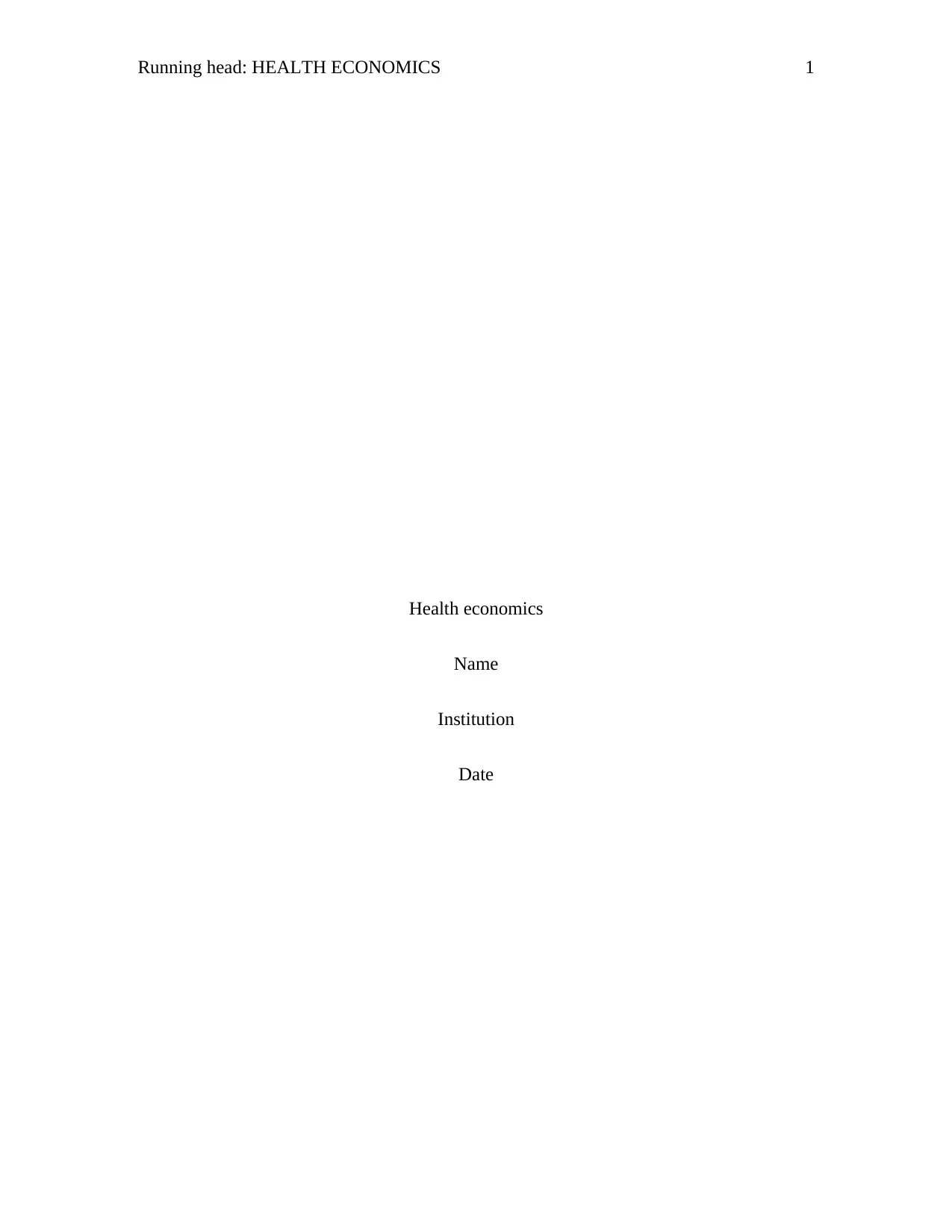
Running head: HEALTH ECONOMICS 1
Health economics
Name
Institution
Date
Health economics
Name
Institution
Date
Paraphrase This Document
Need a fresh take? Get an instant paraphrase of this document with our AI Paraphraser
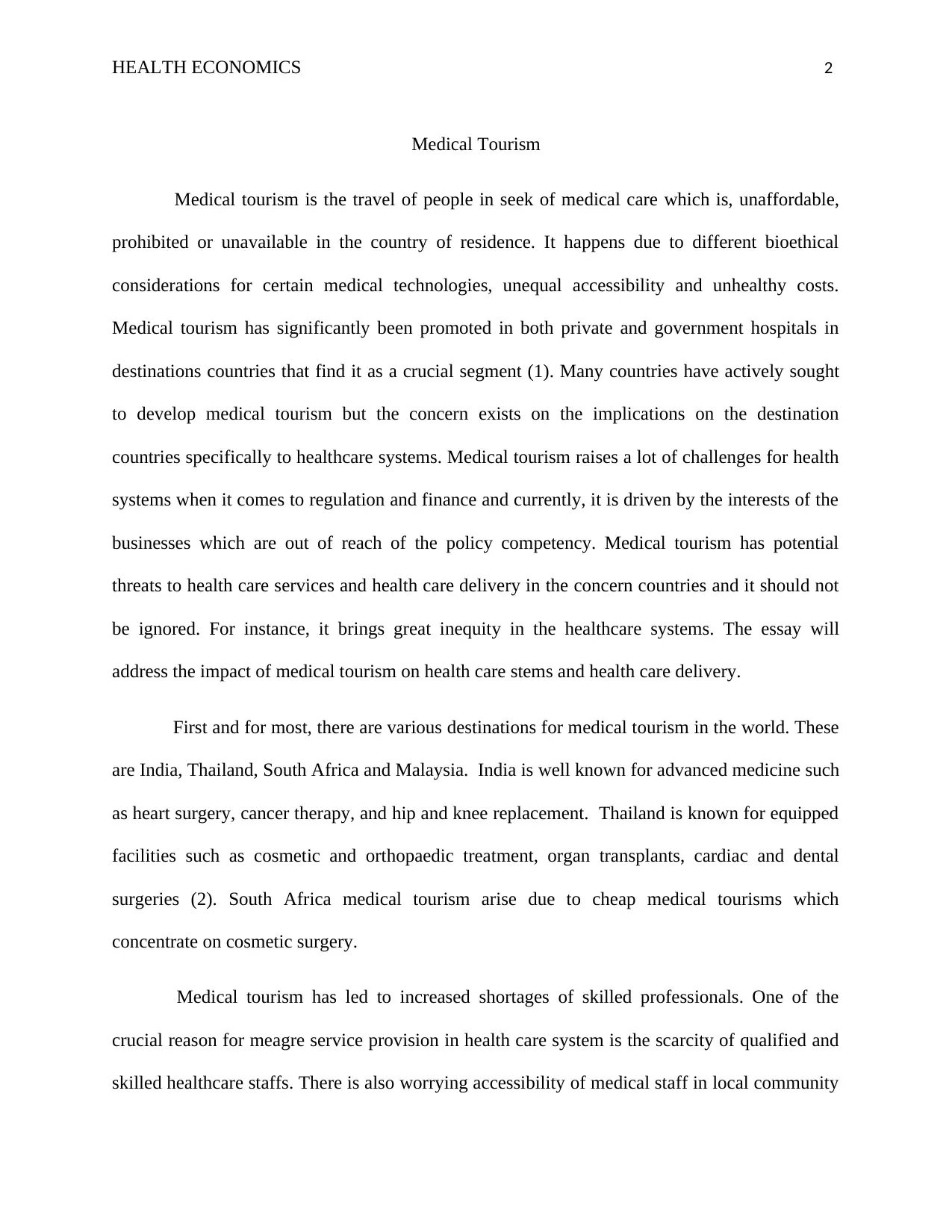
HEALTH ECONOMICS 2
Medical Tourism
Medical tourism is the travel of people in seek of medical care which is, unaffordable,
prohibited or unavailable in the country of residence. It happens due to different bioethical
considerations for certain medical technologies, unequal accessibility and unhealthy costs.
Medical tourism has significantly been promoted in both private and government hospitals in
destinations countries that find it as a crucial segment (1). Many countries have actively sought
to develop medical tourism but the concern exists on the implications on the destination
countries specifically to healthcare systems. Medical tourism raises a lot of challenges for health
systems when it comes to regulation and finance and currently, it is driven by the interests of the
businesses which are out of reach of the policy competency. Medical tourism has potential
threats to health care services and health care delivery in the concern countries and it should not
be ignored. For instance, it brings great inequity in the healthcare systems. The essay will
address the impact of medical tourism on health care stems and health care delivery.
First and for most, there are various destinations for medical tourism in the world. These
are India, Thailand, South Africa and Malaysia. India is well known for advanced medicine such
as heart surgery, cancer therapy, and hip and knee replacement. Thailand is known for equipped
facilities such as cosmetic and orthopaedic treatment, organ transplants, cardiac and dental
surgeries (2). South Africa medical tourism arise due to cheap medical tourisms which
concentrate on cosmetic surgery.
Medical tourism has led to increased shortages of skilled professionals. One of the
crucial reason for meagre service provision in health care system is the scarcity of qualified and
skilled healthcare staffs. There is also worrying accessibility of medical staff in local community
Medical Tourism
Medical tourism is the travel of people in seek of medical care which is, unaffordable,
prohibited or unavailable in the country of residence. It happens due to different bioethical
considerations for certain medical technologies, unequal accessibility and unhealthy costs.
Medical tourism has significantly been promoted in both private and government hospitals in
destinations countries that find it as a crucial segment (1). Many countries have actively sought
to develop medical tourism but the concern exists on the implications on the destination
countries specifically to healthcare systems. Medical tourism raises a lot of challenges for health
systems when it comes to regulation and finance and currently, it is driven by the interests of the
businesses which are out of reach of the policy competency. Medical tourism has potential
threats to health care services and health care delivery in the concern countries and it should not
be ignored. For instance, it brings great inequity in the healthcare systems. The essay will
address the impact of medical tourism on health care stems and health care delivery.
First and for most, there are various destinations for medical tourism in the world. These
are India, Thailand, South Africa and Malaysia. India is well known for advanced medicine such
as heart surgery, cancer therapy, and hip and knee replacement. Thailand is known for equipped
facilities such as cosmetic and orthopaedic treatment, organ transplants, cardiac and dental
surgeries (2). South Africa medical tourism arise due to cheap medical tourisms which
concentrate on cosmetic surgery.
Medical tourism has led to increased shortages of skilled professionals. One of the
crucial reason for meagre service provision in health care system is the scarcity of qualified and
skilled healthcare staffs. There is also worrying accessibility of medical staff in local community

HEALTH ECONOMICS 3
health centres in comparisons with the posts ratified. According to a recent report released in
India, the country is short of 600000 doctors, 200000 dental surgeons and one million nurses. In
addition, 75 percent of all medical staff in India are recruited by the private sector and it suggests
that private sector is a key leading employer of health staffs (3). The increased growth in the
private sector due to increase in the medical tourism has led to internal brain drain. There is a
flow of quality health care specialists from the sector of public health care to the commercial
sector.
Medical tourism has aggravated the issues on accreditation of quality care in Thailand. It
has brought lots of concerns on the quality of the healthcare particularly in the target countries
and it has been on the opinions of opponents of medical tourism (4). The private sector of
Thailand in collaboration with government has brought lots of initiative to counter the situation.
The government has then taken lead in the accreditation process for the private sector.
However, in India, medical tourism has resulted in an unregulated evolution of the
private sector. It is the role of the government in regulating the private sector but it is even
evident that there have been very minimal state interventions. There has not been a clear policy
structure to have harmonized set of laws for the private sector (5). The existing policies have not
been updated and they have been weak and their relevance has been lost completely.
Furthermore, it is evident that there are no constituted mechanisms in the government to tackle
their particular issue. Some constituents of the private sector have resisted accepting the
applicability of some laws of their professions.
Furthermore, in Malaysia, there is considerate subsidies received by the private sector in
form of reduced medical equipment duties and land. The increase in growth of medical tourism
health centres in comparisons with the posts ratified. According to a recent report released in
India, the country is short of 600000 doctors, 200000 dental surgeons and one million nurses. In
addition, 75 percent of all medical staff in India are recruited by the private sector and it suggests
that private sector is a key leading employer of health staffs (3). The increased growth in the
private sector due to increase in the medical tourism has led to internal brain drain. There is a
flow of quality health care specialists from the sector of public health care to the commercial
sector.
Medical tourism has aggravated the issues on accreditation of quality care in Thailand. It
has brought lots of concerns on the quality of the healthcare particularly in the target countries
and it has been on the opinions of opponents of medical tourism (4). The private sector of
Thailand in collaboration with government has brought lots of initiative to counter the situation.
The government has then taken lead in the accreditation process for the private sector.
However, in India, medical tourism has resulted in an unregulated evolution of the
private sector. It is the role of the government in regulating the private sector but it is even
evident that there have been very minimal state interventions. There has not been a clear policy
structure to have harmonized set of laws for the private sector (5). The existing policies have not
been updated and they have been weak and their relevance has been lost completely.
Furthermore, it is evident that there are no constituted mechanisms in the government to tackle
their particular issue. Some constituents of the private sector have resisted accepting the
applicability of some laws of their professions.
Furthermore, in Malaysia, there is considerate subsidies received by the private sector in
form of reduced medical equipment duties and land. The increase in growth of medical tourism
⊘ This is a preview!⊘
Do you want full access?
Subscribe today to unlock all pages.

Trusted by 1+ million students worldwide
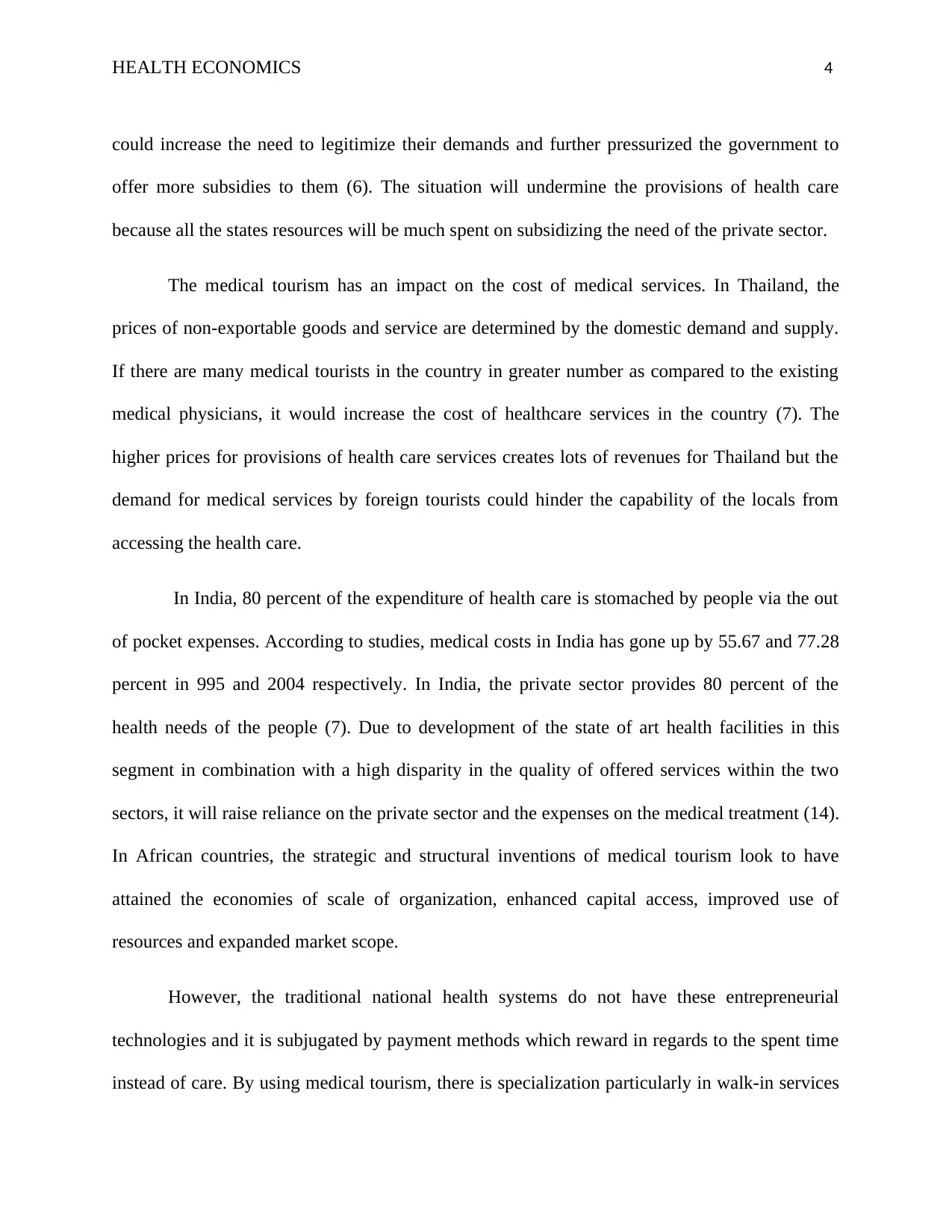
HEALTH ECONOMICS 4
could increase the need to legitimize their demands and further pressurized the government to
offer more subsidies to them (6). The situation will undermine the provisions of health care
because all the states resources will be much spent on subsidizing the need of the private sector.
The medical tourism has an impact on the cost of medical services. In Thailand, the
prices of non-exportable goods and service are determined by the domestic demand and supply.
If there are many medical tourists in the country in greater number as compared to the existing
medical physicians, it would increase the cost of healthcare services in the country (7). The
higher prices for provisions of health care services creates lots of revenues for Thailand but the
demand for medical services by foreign tourists could hinder the capability of the locals from
accessing the health care.
In India, 80 percent of the expenditure of health care is stomached by people via the out
of pocket expenses. According to studies, medical costs in India has gone up by 55.67 and 77.28
percent in 995 and 2004 respectively. In India, the private sector provides 80 percent of the
health needs of the people (7). Due to development of the state of art health facilities in this
segment in combination with a high disparity in the quality of offered services within the two
sectors, it will raise reliance on the private sector and the expenses on the medical treatment (14).
In African countries, the strategic and structural inventions of medical tourism look to have
attained the economies of scale of organization, enhanced capital access, improved use of
resources and expanded market scope.
However, the traditional national health systems do not have these entrepreneurial
technologies and it is subjugated by payment methods which reward in regards to the spent time
instead of care. By using medical tourism, there is specialization particularly in walk-in services
could increase the need to legitimize their demands and further pressurized the government to
offer more subsidies to them (6). The situation will undermine the provisions of health care
because all the states resources will be much spent on subsidizing the need of the private sector.
The medical tourism has an impact on the cost of medical services. In Thailand, the
prices of non-exportable goods and service are determined by the domestic demand and supply.
If there are many medical tourists in the country in greater number as compared to the existing
medical physicians, it would increase the cost of healthcare services in the country (7). The
higher prices for provisions of health care services creates lots of revenues for Thailand but the
demand for medical services by foreign tourists could hinder the capability of the locals from
accessing the health care.
In India, 80 percent of the expenditure of health care is stomached by people via the out
of pocket expenses. According to studies, medical costs in India has gone up by 55.67 and 77.28
percent in 995 and 2004 respectively. In India, the private sector provides 80 percent of the
health needs of the people (7). Due to development of the state of art health facilities in this
segment in combination with a high disparity in the quality of offered services within the two
sectors, it will raise reliance on the private sector and the expenses on the medical treatment (14).
In African countries, the strategic and structural inventions of medical tourism look to have
attained the economies of scale of organization, enhanced capital access, improved use of
resources and expanded market scope.
However, the traditional national health systems do not have these entrepreneurial
technologies and it is subjugated by payment methods which reward in regards to the spent time
instead of care. By using medical tourism, there is specialization particularly in walk-in services
Paraphrase This Document
Need a fresh take? Get an instant paraphrase of this document with our AI Paraphraser
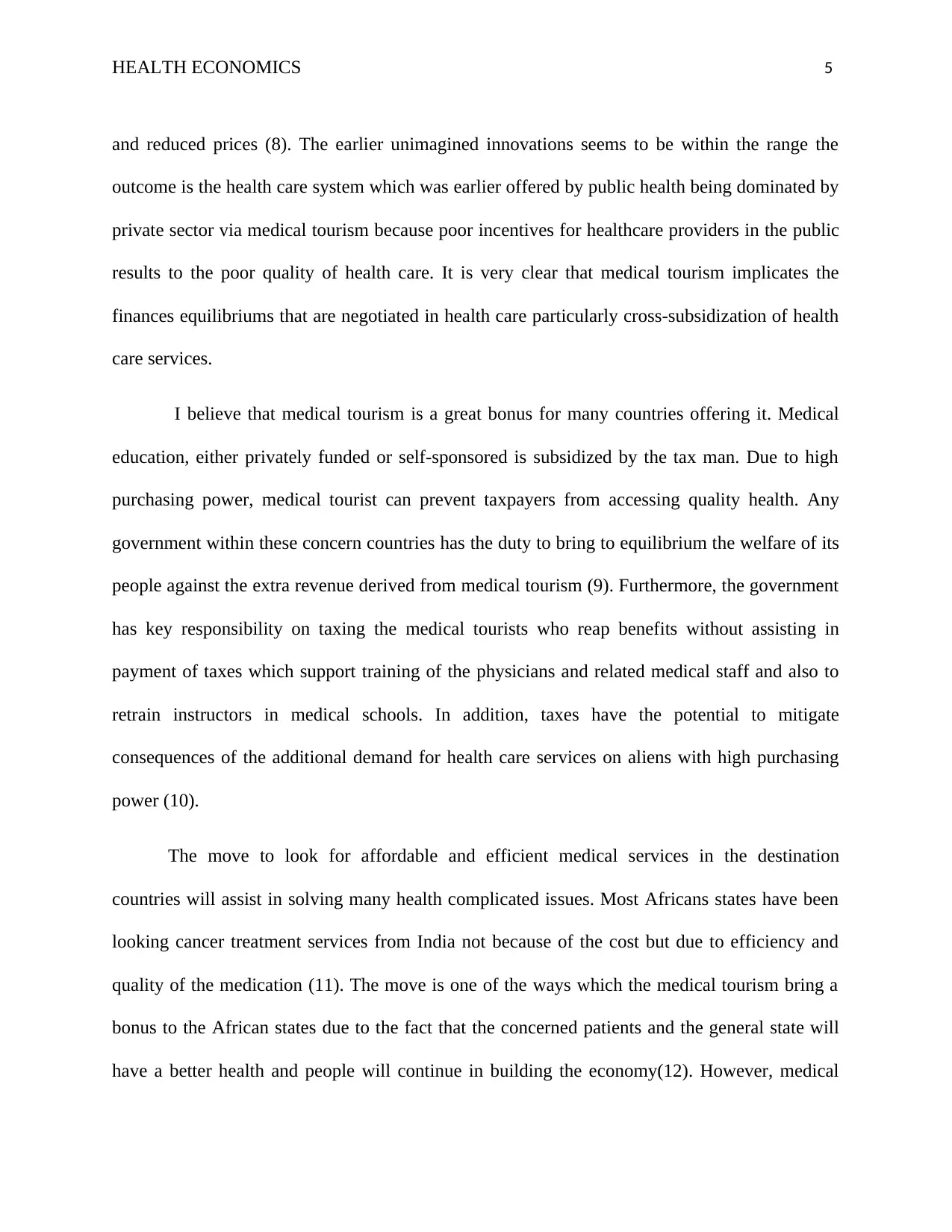
HEALTH ECONOMICS 5
and reduced prices (8). The earlier unimagined innovations seems to be within the range the
outcome is the health care system which was earlier offered by public health being dominated by
private sector via medical tourism because poor incentives for healthcare providers in the public
results to the poor quality of health care. It is very clear that medical tourism implicates the
finances equilibriums that are negotiated in health care particularly cross-subsidization of health
care services.
I believe that medical tourism is a great bonus for many countries offering it. Medical
education, either privately funded or self-sponsored is subsidized by the tax man. Due to high
purchasing power, medical tourist can prevent taxpayers from accessing quality health. Any
government within these concern countries has the duty to bring to equilibrium the welfare of its
people against the extra revenue derived from medical tourism (9). Furthermore, the government
has key responsibility on taxing the medical tourists who reap benefits without assisting in
payment of taxes which support training of the physicians and related medical staff and also to
retrain instructors in medical schools. In addition, taxes have the potential to mitigate
consequences of the additional demand for health care services on aliens with high purchasing
power (10).
The move to look for affordable and efficient medical services in the destination
countries will assist in solving many health complicated issues. Most Africans states have been
looking cancer treatment services from India not because of the cost but due to efficiency and
quality of the medication (11). The move is one of the ways which the medical tourism bring a
bonus to the African states due to the fact that the concerned patients and the general state will
have a better health and people will continue in building the economy(12). However, medical
and reduced prices (8). The earlier unimagined innovations seems to be within the range the
outcome is the health care system which was earlier offered by public health being dominated by
private sector via medical tourism because poor incentives for healthcare providers in the public
results to the poor quality of health care. It is very clear that medical tourism implicates the
finances equilibriums that are negotiated in health care particularly cross-subsidization of health
care services.
I believe that medical tourism is a great bonus for many countries offering it. Medical
education, either privately funded or self-sponsored is subsidized by the tax man. Due to high
purchasing power, medical tourist can prevent taxpayers from accessing quality health. Any
government within these concern countries has the duty to bring to equilibrium the welfare of its
people against the extra revenue derived from medical tourism (9). Furthermore, the government
has key responsibility on taxing the medical tourists who reap benefits without assisting in
payment of taxes which support training of the physicians and related medical staff and also to
retrain instructors in medical schools. In addition, taxes have the potential to mitigate
consequences of the additional demand for health care services on aliens with high purchasing
power (10).
The move to look for affordable and efficient medical services in the destination
countries will assist in solving many health complicated issues. Most Africans states have been
looking cancer treatment services from India not because of the cost but due to efficiency and
quality of the medication (11). The move is one of the ways which the medical tourism bring a
bonus to the African states due to the fact that the concerned patients and the general state will
have a better health and people will continue in building the economy(12). However, medical
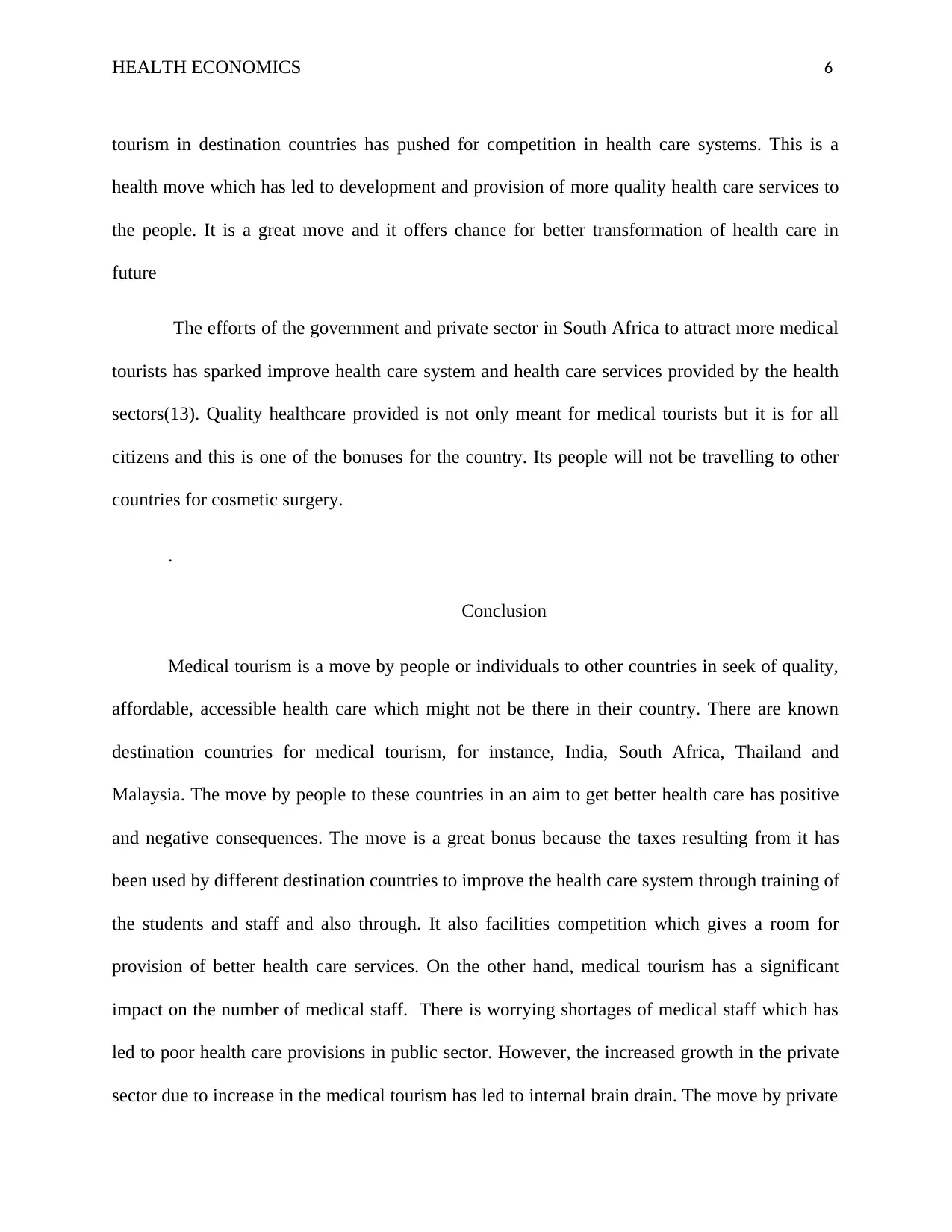
HEALTH ECONOMICS 6
tourism in destination countries has pushed for competition in health care systems. This is a
health move which has led to development and provision of more quality health care services to
the people. It is a great move and it offers chance for better transformation of health care in
future
The efforts of the government and private sector in South Africa to attract more medical
tourists has sparked improve health care system and health care services provided by the health
sectors(13). Quality healthcare provided is not only meant for medical tourists but it is for all
citizens and this is one of the bonuses for the country. Its people will not be travelling to other
countries for cosmetic surgery.
.
Conclusion
Medical tourism is a move by people or individuals to other countries in seek of quality,
affordable, accessible health care which might not be there in their country. There are known
destination countries for medical tourism, for instance, India, South Africa, Thailand and
Malaysia. The move by people to these countries in an aim to get better health care has positive
and negative consequences. The move is a great bonus because the taxes resulting from it has
been used by different destination countries to improve the health care system through training of
the students and staff and also through. It also facilities competition which gives a room for
provision of better health care services. On the other hand, medical tourism has a significant
impact on the number of medical staff. There is worrying shortages of medical staff which has
led to poor health care provisions in public sector. However, the increased growth in the private
sector due to increase in the medical tourism has led to internal brain drain. The move by private
tourism in destination countries has pushed for competition in health care systems. This is a
health move which has led to development and provision of more quality health care services to
the people. It is a great move and it offers chance for better transformation of health care in
future
The efforts of the government and private sector in South Africa to attract more medical
tourists has sparked improve health care system and health care services provided by the health
sectors(13). Quality healthcare provided is not only meant for medical tourists but it is for all
citizens and this is one of the bonuses for the country. Its people will not be travelling to other
countries for cosmetic surgery.
.
Conclusion
Medical tourism is a move by people or individuals to other countries in seek of quality,
affordable, accessible health care which might not be there in their country. There are known
destination countries for medical tourism, for instance, India, South Africa, Thailand and
Malaysia. The move by people to these countries in an aim to get better health care has positive
and negative consequences. The move is a great bonus because the taxes resulting from it has
been used by different destination countries to improve the health care system through training of
the students and staff and also through. It also facilities competition which gives a room for
provision of better health care services. On the other hand, medical tourism has a significant
impact on the number of medical staff. There is worrying shortages of medical staff which has
led to poor health care provisions in public sector. However, the increased growth in the private
sector due to increase in the medical tourism has led to internal brain drain. The move by private
⊘ This is a preview!⊘
Do you want full access?
Subscribe today to unlock all pages.

Trusted by 1+ million students worldwide

HEALTH ECONOMICS 7
sectors to be subsidized by the government has drained government resources which could be
used in the provision of better healthcare services and better health care system.
Reference List
1. Bennie R. Medical tourism: A look at how medical outsourcing can reshape health care.
Tex. Int'l LJ. 2014;49:583.
2. Ormond M, Sulianti D. More than medical tourism: lessons from Indonesia and Malaysia
on South-South intra-regional medical travel. Current Issues in Tourism. 2017 Jan
2;20(1):94-110.
3. Mary SR. Medical tourism in Asia-An overview. IRMJCR. 2014;10:122-37
4. Hanefeld J, Smith R, Horsfall D, Lunt N. What do we know about medical tourism? A
review of the literature with a discussion of its implications for the UK National Health
Service as an example of a public health care system. Journal of travel medicine. 2014
Aug 25; 21(6):410-7.
5. Lunt N, Horsfall D, Hanefeld J, editors. Handbook on medical tourism and patient
mobility. Edward Elgar Publishing; 2015 Jun 29.
6. Ormond M, Mun WK, Khoon CC. Medical tourism in Malaysia: how can we better
identify and manage its advantages and disadvantages?. Global health action. 2014 Dec
1;7(1):25201
7. Snyder J, Crooks VA, Turner L, Johnston R. Understanding the impacts of medical
tourism on health human resources in Barbados: a prospective, qualitative study of
stakeholder perceptions. International journal for equity in health. 2013 Jan 5;12(1):2.
sectors to be subsidized by the government has drained government resources which could be
used in the provision of better healthcare services and better health care system.
Reference List
1. Bennie R. Medical tourism: A look at how medical outsourcing can reshape health care.
Tex. Int'l LJ. 2014;49:583.
2. Ormond M, Sulianti D. More than medical tourism: lessons from Indonesia and Malaysia
on South-South intra-regional medical travel. Current Issues in Tourism. 2017 Jan
2;20(1):94-110.
3. Mary SR. Medical tourism in Asia-An overview. IRMJCR. 2014;10:122-37
4. Hanefeld J, Smith R, Horsfall D, Lunt N. What do we know about medical tourism? A
review of the literature with a discussion of its implications for the UK National Health
Service as an example of a public health care system. Journal of travel medicine. 2014
Aug 25; 21(6):410-7.
5. Lunt N, Horsfall D, Hanefeld J, editors. Handbook on medical tourism and patient
mobility. Edward Elgar Publishing; 2015 Jun 29.
6. Ormond M, Mun WK, Khoon CC. Medical tourism in Malaysia: how can we better
identify and manage its advantages and disadvantages?. Global health action. 2014 Dec
1;7(1):25201
7. Snyder J, Crooks VA, Turner L, Johnston R. Understanding the impacts of medical
tourism on health human resources in Barbados: a prospective, qualitative study of
stakeholder perceptions. International journal for equity in health. 2013 Jan 5;12(1):2.
Paraphrase This Document
Need a fresh take? Get an instant paraphrase of this document with our AI Paraphraser
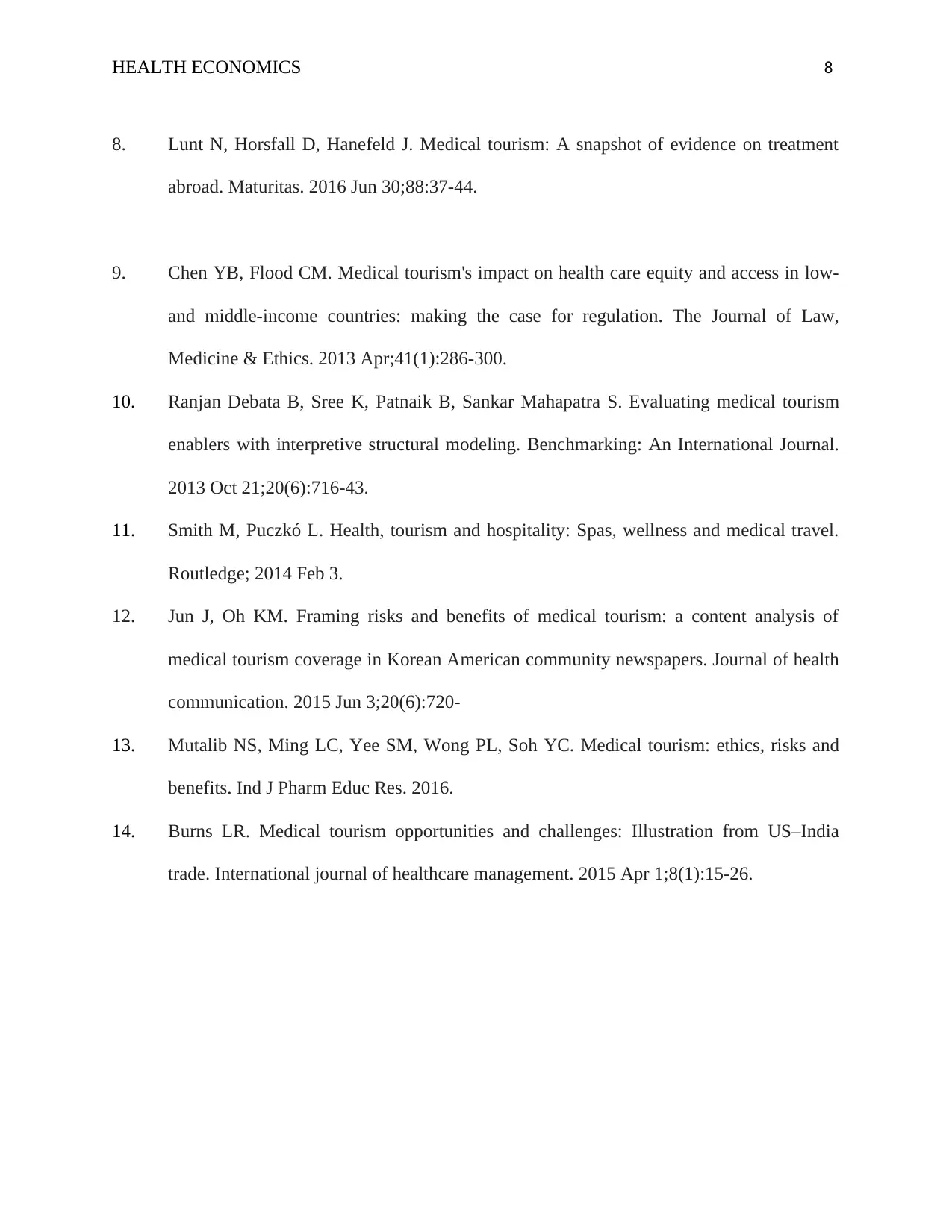
HEALTH ECONOMICS 8
8. Lunt N, Horsfall D, Hanefeld J. Medical tourism: A snapshot of evidence on treatment
abroad. Maturitas. 2016 Jun 30;88:37-44.
9. Chen YB, Flood CM. Medical tourism's impact on health care equity and access in low-
and middle-income countries: making the case for regulation. The Journal of Law,
Medicine & Ethics. 2013 Apr;41(1):286-300.
10. Ranjan Debata B, Sree K, Patnaik B, Sankar Mahapatra S. Evaluating medical tourism
enablers with interpretive structural modeling. Benchmarking: An International Journal.
2013 Oct 21;20(6):716-43.
11. Smith M, Puczkó L. Health, tourism and hospitality: Spas, wellness and medical travel.
Routledge; 2014 Feb 3.
12. Jun J, Oh KM. Framing risks and benefits of medical tourism: a content analysis of
medical tourism coverage in Korean American community newspapers. Journal of health
communication. 2015 Jun 3;20(6):720-
13. Mutalib NS, Ming LC, Yee SM, Wong PL, Soh YC. Medical tourism: ethics, risks and
benefits. Ind J Pharm Educ Res. 2016.
14. Burns LR. Medical tourism opportunities and challenges: Illustration from US–India
trade. International journal of healthcare management. 2015 Apr 1;8(1):15-26.
8. Lunt N, Horsfall D, Hanefeld J. Medical tourism: A snapshot of evidence on treatment
abroad. Maturitas. 2016 Jun 30;88:37-44.
9. Chen YB, Flood CM. Medical tourism's impact on health care equity and access in low-
and middle-income countries: making the case for regulation. The Journal of Law,
Medicine & Ethics. 2013 Apr;41(1):286-300.
10. Ranjan Debata B, Sree K, Patnaik B, Sankar Mahapatra S. Evaluating medical tourism
enablers with interpretive structural modeling. Benchmarking: An International Journal.
2013 Oct 21;20(6):716-43.
11. Smith M, Puczkó L. Health, tourism and hospitality: Spas, wellness and medical travel.
Routledge; 2014 Feb 3.
12. Jun J, Oh KM. Framing risks and benefits of medical tourism: a content analysis of
medical tourism coverage in Korean American community newspapers. Journal of health
communication. 2015 Jun 3;20(6):720-
13. Mutalib NS, Ming LC, Yee SM, Wong PL, Soh YC. Medical tourism: ethics, risks and
benefits. Ind J Pharm Educ Res. 2016.
14. Burns LR. Medical tourism opportunities and challenges: Illustration from US–India
trade. International journal of healthcare management. 2015 Apr 1;8(1):15-26.
1 out of 8
Related Documents
Your All-in-One AI-Powered Toolkit for Academic Success.
+13062052269
info@desklib.com
Available 24*7 on WhatsApp / Email
![[object Object]](/_next/static/media/star-bottom.7253800d.svg)
Unlock your academic potential
Copyright © 2020–2025 A2Z Services. All Rights Reserved. Developed and managed by ZUCOL.





